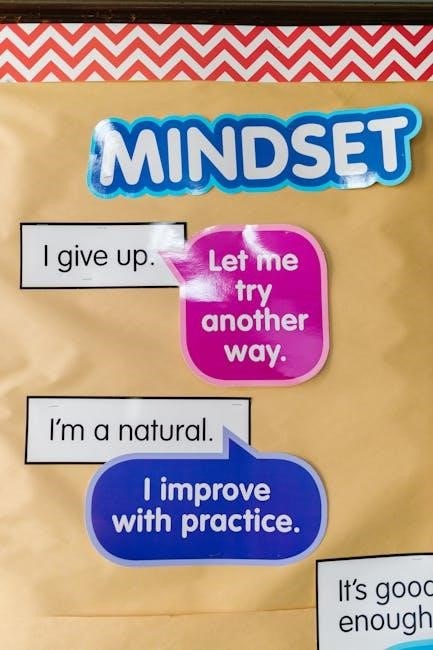A Different Mirror: Article Plan
This article aims to explore Ronald Takaki’s “A Different Mirror,” examining its central argument for a multicultural perspective on American history. We will delve into the key ethnic groups explored, the book’s impact, and the themes of race, class, and identity it presents. A critical analysis and information regarding PDF availability will also be included.
Overview of “A Different Mirror” by Ronald Takaki
Ronald Takaki’s “A Different Mirror: A History of Multicultural America” presents a compelling revisionist history, challenging traditional narratives by exploring the diverse experiences of ethnic groups often marginalized in mainstream accounts. This seminal work delves into the histories of Native Americans, African Americans, Asian Americans, and Latinx communities, weaving together their stories to create a richer, more complex tapestry of the American past.
Takaki’s approach seeks to dismantle the dominant, Eurocentric perspective, offering a “different mirror” through which to view the nation’s formation and development. The book examines themes of race, class, and identity, highlighting the struggles and contributions of these diverse groups. It emphasizes how these experiences have shaped American culture, politics, and society.
“A Different Mirror” serves as both a historical analysis and a call for a more inclusive understanding of American identity. Takaki’s work encourages readers to confront uncomfortable truths about the nation’s past and to recognize the importance of multiculturalism in shaping its future. The book is widely used in educational settings and is also available in PDF format.
Takaki’s Central Argument: Multicultural History
At the heart of Ronald Takaki’s “A Different Mirror” lies the argument that American history is fundamentally multicultural. He asserts that a true understanding of the nation’s past requires acknowledging and exploring the experiences of all its peoples, not just those of European descent. Takaki challenges the traditional, often whitewashed narratives that have dominated historical accounts, arguing that they present an incomplete and inaccurate picture of the American story.
Takaki demonstrates that the contributions and struggles of various ethnic groups—Native Americans, African Americans, Asian Americans, and Latinx communities—are integral to understanding the development of American society, culture, and politics. He emphasizes how these groups have shaped the nation through their labor, resistance, and cultural innovations.
By weaving together these diverse narratives, Takaki constructs a more nuanced and comprehensive historical account. His work highlights the interconnectedness of these experiences, revealing how race, class, and power have shaped the lives of all Americans. The goal is to foster a more inclusive and equitable understanding of American identity. “A Different Mirror” is available in PDF format.
Key Ethnic Groups Explored in the Book
Ronald Takaki’s “A Different Mirror” meticulously examines the experiences of numerous ethnic groups, offering a multifaceted perspective on American history. Among the key groups explored are Native Americans, whose history of displacement, resistance, and cultural preservation forms a crucial part of the American narrative. The book delves into the impact of colonization, forced removal, and the ongoing struggle for sovereignty.
African Americans are another central focus, with Takaki exploring the legacy of slavery, the Civil Rights Movement, and the continued fight for racial equality. He highlights the contributions of African Americans to American culture, music, and literature.
Asian Americans also receive significant attention, with Takaki examining the experiences of Chinese, Japanese, Filipino, and other Asian communities. He discusses the challenges of immigration, discrimination, and the struggle to overcome stereotypes, as well as their vital roles in the nation’s economic development.
Finally, the book explores the experiences of Latinx communities, examining their history of immigration, labor struggles, and cultural contributions. Takaki emphasizes the diversity within the Latinx population and their ongoing fight for social and political inclusion. The PDF version is a popular format.
Impact on Understanding American History
“A Different Mirror” has profoundly reshaped the understanding of American history by challenging traditional, Eurocentric narratives. Takaki’s work underscores the significance of incorporating diverse voices and experiences to gain a more accurate and complete picture of the nation’s past. By highlighting the contributions and struggles of various ethnic groups, the book reveals the complex interplay of race, class, and power that has shaped American society.
The book’s impact extends to educational institutions, where it has become a staple in ethnic studies, history, and American literature courses. It encourages critical thinking about historical events and challenges students to question dominant narratives. “A Different Mirror” also promotes a more inclusive and empathetic understanding of American identity.
Furthermore, Takaki’s work has influenced public discourse on issues of race and inequality. By providing a historical context for contemporary challenges, the book helps to foster dialogue and promote social justice. Its accessible writing style and compelling narratives have made it a valuable resource for educators, activists, and anyone seeking a deeper understanding of American history. The availability of “A Different Mirror” in PDF format further enhances its accessibility to a wider audience.
The Concept of “A Different Mirror” Explained

The concept of “A Different Mirror,” as introduced by Ronald Takaki, refers to the idea of viewing American history through the lens of multiculturalism. It encourages a shift away from the traditional, dominant narrative that primarily focuses on European perspectives. Instead, Takaki proposes that we examine the experiences and contributions of various ethnic groups, including Native Americans, African Americans, Asian Americans, and Latinx communities.
This “different mirror” allows us to see a more complete and accurate reflection of American society. It reveals the hidden histories, struggles, and triumphs of marginalized groups, challenging the notion of a singular, unified American identity. By understanding the diverse perspectives that have shaped the nation, we can gain a deeper appreciation for the complexities of American history.
Takaki’s concept emphasizes the importance of recognizing the ways in which race, class, and power have influenced historical events. It encourages critical analysis of historical sources and challenges readers to question dominant narratives. “A Different Mirror” ultimately aims to promote a more inclusive and equitable understanding of American history, fostering empathy and social justice. The accessibility of the book in PDF format allows for wider dissemination of this important concept.
Themes of Race, Class, and Identity
Ronald Takaki’s “A Different Mirror” intricately weaves together the themes of race, class, and identity to present a comprehensive understanding of American history. The book explores how racial classifications have been historically constructed and used to justify oppression and inequality. Takaki examines the experiences of various ethnic groups, revealing how their identities have been shaped by racial discrimination and social hierarchies.
Class plays a crucial role in Takaki’s analysis, as he demonstrates how economic exploitation and disparities have intersected with race to create systemic disadvantages for certain communities. He highlights the struggles of working-class individuals from diverse backgrounds, exposing the ways in which capitalism and social structures have perpetuated inequality.
Furthermore, “A Different Mirror” delves into the complexities of identity formation in a multicultural society. Takaki explores how individuals negotiate their sense of self within the context of their ethnic heritage, racial identity, and social class. The book emphasizes the importance of recognizing the multiple and overlapping identities that shape our experiences. By examining these themes, Takaki challenges readers to confront the legacies of racism, classism, and discrimination that continue to impact American society. The availability of the text in PDF format makes these critical insights accessible to a broader audience.

Criticism and Reception of Takaki’s Work

Ronald Takaki’s “A Different Mirror” has garnered significant attention and sparked diverse reactions since its publication. Many critics have lauded the book for its groundbreaking approach to American history, praising Takaki’s ability to weave together the experiences of various ethnic groups into a cohesive narrative. The book has been commended for challenging traditional historical accounts and promoting a more inclusive understanding of the nation’s past.
However, “A Different Mirror” has also faced criticism from some quarters. Some scholars have argued that Takaki’s focus on multiculturalism overlooks the unifying aspects of American identity. Others have questioned the book’s selection of ethnic groups, suggesting that certain communities are underrepresented or misrepresented. Additionally, some critics have raised concerns about the book’s accessibility, arguing that its academic language and complex arguments may be challenging for general readers.
Despite these criticisms, “A Different Mirror” remains a widely influential work in the field of American history. Its impact on shaping discussions about race, ethnicity, and identity is undeniable. The book continues to be used in classrooms across the country, prompting students to engage with diverse perspectives and critically examine the narratives that shape their understanding of American history. The availability of “A Different Mirror” in PDF format has further expanded its reach, allowing readers from all backgrounds to access Takaki’s important insights.
“A Different Mirror” for Young People Adaptation
Recognizing the importance of introducing multicultural perspectives to younger audiences, Ronald Takaki’s “A Different Mirror” has been adapted into a version specifically designed for young people. This adaptation aims to make the complex themes and historical narratives of the original work more accessible and engaging for middle and high school students. The “A Different Mirror for Young People” edition retains the core arguments and central thesis of Takaki’s original book, while simplifying the language and incorporating age-appropriate examples and anecdotes.
This adapted version often includes supplementary materials such as discussion questions, timelines, and primary source documents to enhance the learning experience. The goal is to encourage young readers to think critically about issues of race, ethnicity, and identity in American history. By presenting diverse perspectives and challenging traditional narratives, the adaptation hopes to foster a more inclusive and nuanced understanding of the nation’s past.
The “A Different Mirror for Young People” adaptation has been widely used in classrooms across the country, serving as a valuable resource for educators seeking to promote multicultural education. Its availability in various formats, including print and potentially PDF, makes it accessible to a broad range of students and educators. This adaptation ensures that Takaki’s important work continues to inspire and educate future generations.
Availability of “A Different Mirror” in PDF Format

The increasing demand for digital resources has led to widespread interest in the availability of Ronald Takaki’s “A Different Mirror” in PDF format. While obtaining a legitimate PDF copy for free can be challenging due to copyright restrictions, several avenues exist for accessing the book digitally. Many online platforms offer the option to purchase the e-book version of “A Different Mirror,” which can then be downloaded as a PDF.
Additionally, some educational institutions and libraries may provide access to the book in PDF format through their online databases or digital lending programs. Students and researchers should check with their local libraries or university resources to explore these possibilities.
It is important to exercise caution when searching for free PDF downloads of copyrighted material, as many websites offering such downloads may be unreliable or illegal. These sites may contain malware or distribute unauthorized copies of the book, infringing on copyright laws.
Always prioritize purchasing the e-book from reputable online retailers or accessing it through legitimate educational channels to ensure that you are obtaining a legal and safe copy of “A Different Mirror” in PDF format. This supports the author and publisher while providing convenient digital access to this important work.



